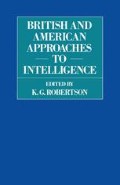Abstract
The aim of this chapter is to examine the military dimension of British intelligence in the aftermath of World War I and to draw out a number of general observations concerning the practice of intelligence.1 After a survey of the structure and scope of military intelligence during the period in question, three case-studies are taken to illustrate different aspects of the topic. The first deals with senior war office involvement in and reaction to specific political intelligence-gathering: the intercept operation against the Russian Trade Delegation in 1920. The second looks at a local military intelligence operation — so far as the evidence allows — and assesses the influence (if any) exerted on British policy by intelligence collected in Constantinople. The third case-study investigates the military role in domestic intelligence work — both in Great Britain and Ireland. Finally, military intelligence during the 1920s is briefly examined in terms of the specific functions of collection, analysis, counter-intelligence and covert action.
Access this chapter
Tax calculation will be finalised at checkout
Purchases are for personal use only
Preview
Unable to display preview. Download preview PDF.
Notes
F. S. G. Piggott, Broken Thread (Aldershot, 1950) p. 113.
F. H. Hinsley et al., British Intelligence in the Second World War, vol. I (London, 1979) p. 14, wrongly states that the Intelligence Corps was abolished in 1918. It would be more correct to say that it faded away (suitably) after the war. Elements of the Corps survived 1918. Isaac, ‘History’, p. 24, notes an Intelligence Corps at Constantinople represented in the January 1922 Monthly Army List.
A. C. Temperley, The Whispering Gallery of Europe (London, 1938) p. 16.
Lord Ironside (ed.), High Road to Command: the Diaries of Major General Sir Edmund Ironside 1920–22 (London, 1972) p. 84.
Christopher Andrew ‘The British Secret Service and Anglo-Soviet Relations in the 1920s Part I: From the Trade Negotiations to the Zinoviev Letter’, The Historical Journal, vol. 20, no. 3 (1977) p. 683.
This subject is dealt with extensively in Keith Jeffery and Peter Hennessy, States of Emergency: British Governments and Strikebreaking since 1919 (London, 1983).
The best account of the negotiations is in Richard H. Ullman, Anglo-Soviet Relations, 1917–1921, III: the Anglo-Soviet Accord, (Princeton University Press, 1972) passim.
Churchill to Thwaites, 20 August 1920, Martin Gilbert, Winston S. Churchill, vol. IV, Companion, part 2, (London, 1977) p. 1175.
This divergence in military and political opinion is discussed in Keith Jeffery, The British Army and the Crisis of Empire 1918–1922, (Manchester, 1984) pp. 40–4.
This topic is covered in Keith Jeffery, ‘The British Army and Internal Security, 1919–39’ The Historical Journal, vol. 24, no. 2 (1981) pp. 377–97.
The best account of security policy in Ireland during this period is Charles Townshend, The British Campaign in Ireland 1919–1921 (Oxford, 1975).
See Eunan O’Halpin, ‘British Intelligence in Ireland, 1914–1921’, in Christopher Andrew and David Dilks (eds), The Missing Dimension: Governments and Intelligence Communities in the Twentieth Century (London, 1984) pp. 54–77.
Sir Tom Bridges, Alarms and Excursions, (London, 1938) pp. 203, 207.
William Y. Darling, So It Looks to Me (London, 1953) p. 280.
For the Irish Bulletin affair, and the propaganda war generally see D. G. Boyce, Englishmen and Irish Troubles: British Public Opinion and the Making of Irish Policy 1918–22 (London, 1972) pp. 83–102.
See also C. J. C. Street, Ireland in 1921 (London, 1922) p. 303, and Winters Tale, pp. 307–8, where Winter names Darling as responsible for the bogus Bulletin.
See, for example, David Neligan, The Spy in the Castle (London, 1968), and
Leon O Broin, ‘Dave Neligan, “The Spy in the Castle”’, The Irish Sword, vol. XV, no. 61 (1983) pp. 271–6.
These elements are as developed by Roy Godson, especially in his (editor), Intelligence Requirements for the 1980s: Elements of Intelligence (Washington DC, rev. edn 1983).
Editor information
Editors and Affiliations
Copyright information
© 1987 Royal United Services Institute
About this chapter
Cite this chapter
Jeffery, K. (1987). British Military Intelligence Following World War I. In: Robertson, K.G. (eds) British and American Approaches to Intelligence. RUSI Defence Studies. Palgrave Macmillan, London. https://doi.org/10.1007/978-1-349-08418-0_3
Download citation
DOI: https://doi.org/10.1007/978-1-349-08418-0_3
Publisher Name: Palgrave Macmillan, London
Print ISBN: 978-1-349-08420-3
Online ISBN: 978-1-349-08418-0
eBook Packages: Palgrave Political & Intern. Studies CollectionPolitical Science and International Studies (R0)

